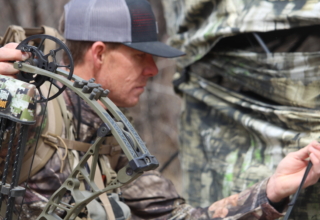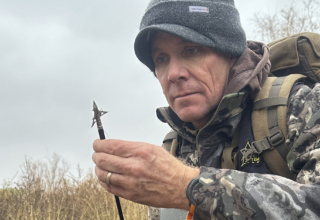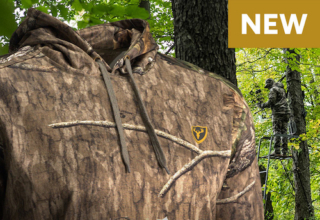May is a fantastic month to invade the turkey woods and battle a boy bird. Heed these four tried-and-true turkey tips, and you’ll WIN more than you lose.
I’m a turkey fanatic. In addition to hunting in my home state of Colorado each spring, I hit the Longbeard Highway and travel to various states. I’ve completed the Wild Turkey Grand Slam twice, penned a turkey book, and am currently chasing the Wild Turkey Super Slam—harvesting a turkey in all 49 states that harbor a huntable turkey population.
My obsession with turkey hunting keeps me in the spring woods for extended periods. As the calendar flips from April to May, the turkey woods undergo a transformation. It’s crucial to stay on top of these changes, as they can significantly impact your turkey hunting success.
Here are four tips for May turkey goers to keep in mind. Put them to practice, and wild turkey will be on the dinner menu often in the coming weeks.
May Tip #1 – Pull The Strutter
Some may disagree with me on my May no-strutter decoy rule, but before you pick a side, read on.
By May, many two-year-old birds have had their butts whipped a time or two. Three and four-year-old birds have battled, too, and many start to get gun-shy. Spurs to the head and side aren’t fun, and depending on the bird and its general flee or fight attitude, many no longer want to pick a fight with a dominant boy bird.
Think of it this way: You walk into a bar to confront the guy your girlfriend left you for. Sadly, this isn’t your first time in a situation like this. The first time, the dude looked like he lived in the gym, and all you have to show for your effort is a scar over your left eye. This time, the guy looks like a beanpole, won’t make eye contact with you, and seems submissive. This will boost your confidence.
Turkeys are no different. Pick a 1/4- or 1/2-strut jake decoy, set him four or five yards from your hen fake of choice, and don’t have him look directly at her.

You’ll have more success with this type of setup. If area toms still seem like they don’t want to play, go with a single hen decoy.
May Tip #2 – Roam The Woods
During March and April, I’m a patient turkey hunter. I try to pattern birds, figure out when and where they want to be, and set up in those areas and wait them out.
There are multiple reasons for this. Typically, boy birds want to tag along behind hens during the early season, and can be challenging to call. Another reason for my stay-patient early-season tactic is the trees and bushes in the woods are naked.
Turkeys have remarkable eyesight, and birds spot you from a mile away when the trees and bushes aren’t leafed out.
Now that spring is in full swing, boy birds are roaming as many hens have been bred. Because the woods are turning green, you can use the terrain and cover to make run-and-gun moves. And, friends, I promise there is no more fun way to hunt turkeys than running ridges trying to get a gobbler to fire.

May Tip #3 – Sleep In
I’ve always struggled with hunting birds off the roost in the morning. It doesn’t matter what time of year; I kill most of my springtime noisemakers between 9 a.m. and 1 p.m. Be sure to check state regulations, as several states limit turkey hours to 1/2 hour before sunrise to noon.
Come May, I’ve been on the turkey grind for over a month. My body is tired, and as much as I love hearing gobbles tease a morning to life, it feels good to sleep in.
By May 1, many hens pitch down, peck around, and head to their nests. This means more boy birds are roaming, looking for love, making 9 a.m. to 1 p.m. an excellent time to fire up a gobbler and give him a ride out of the woods in your vest or over your shoulder.

My favorite skip-the-morning-roost-hunt tactic is to walk ridges, creek and river bottoms, etc., until I find a fresh turkey sign. Strut marks, tracks, droppings, scratching, and dusting locales are all tell-tale signs birds are in the area.
Once I locate the turkey sign, I listen for a few minutes. Too many times, we are too quick to get on the calls. I learned while elk hunting many years ago that if I get around animals, chances are good they will make noise.

When I hear animals and only have to call once I get to the exact location I want, my success rate goes way up. If I don’t hear birds, I wait for a break in the wind and hit a crow call, owl hoot, or hawk screech. In recent years, I’ve had more luck with a hawk screech than any other locator call.
If my locator calls fall on deaf ears, I move to an area that provides a good hide, get the sun to my back, walk about 40 yards from where I want to shoot an approaching bird, make a few hen calls, and then return to my hide. Turkeys key in on the exact spot they hear a call. By moving away from your hide and making a call or two, you’ll have the upper hand as turkeys won’t be right on top of you. They will be looking for the hen, and not you.
I will stay in this location, calling every fifteen minutes, for an hour before moving on.
May Tip #4 – Get A Red Dot & Great Turkey Ammo
I don’t own or have permission to hunt vast acres of turkey paradise. I hunt many public and small private tracts that I share with other hunters. By May, birds have gotten wise, and my 20—and 30-yard in-the-decoys chip shots can be 50- and 60-yard drive-bys.
I’m not promoting unethical turkey hunting, and I’m not suggesting you take long shots. I recommend that you practice with a shotgun with loads capable of folding a bird up to 60 yards. This will give you the confidence to make a killing shot at this range, but practice at longer ranges also makes you even more deadly at closer ranges.
Spend time on the range patterning your shotgun. I recommend topping your favorite turkey killer with a red-dot sight. Burris and Leupold make some excellent ones.

I also recommend a full or extra-full choke—factory or custom—and pairing that choke with 3-inch Hevi-Shot Hevi-18 TSS Turkey in 12 Gauge 9 Shot or Winchester’s Long Beard XR 5 Shot.
I’ve tested both loads extensively on the range and have pummeled several spring birds with them. Both are lethal to 60 yards. The Hevi-18 TSS 9 Shot has a 2-ounce payload, and because the TSS pellets are size #9, you get a lot of TSS in the air.
The Long Beard XR 5 Shot gives you a 1-3/4-ounce payload and promises twice the number of pellets in a 10-inch circle out to 60 yards compared head-to-head against traditional lead turkey loads.
We all crave a close encounter, but if birds are stubborn, it sure is nice to reach out and touch them.
Final Thoughts
May is an excellent time to bag your bird. Stay focused and grind hard for the next two weeks. I’ve had fantastic luck from May 1 to May 15. After May 15, the turkey rut starts winding down. When you combine “over it” birds with torrid temps, your odds of success dip way down.









